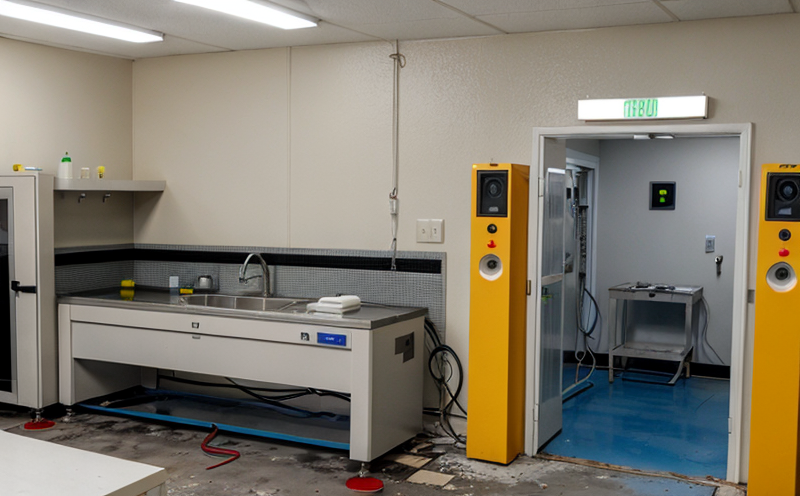ASTM D7283 Radiological Contamination in Water by Gross Alpha/Beta
The ASTM D7283 standard is a widely recognized method used to assess radiological contamination levels in water through the detection of gross alpha and beta particles. This test is crucial for quality managers, compliance officers, R&D engineers, and procurement professionals who need accurate data on the presence of radionuclides in various water sources.
The primary objective of this test is to ensure that water supplies are safe from harmful levels of radioactive contamination. By detecting gross alpha and beta emitters, ASTM D7283 helps identify potential risks associated with nuclear waste disposal, industrial processes involving radioactive materials, or natural occurrences such as radon in groundwater.
The methodology involves collecting a representative sample of the water under test conditions, typically at the point where it is most likely to be contaminated. The samples are then analyzed using specialized instrumentation capable of measuring alpha and beta particle emissions.
Understanding the significance of this test extends beyond just detecting contamination; it also plays an essential role in regulatory compliance, environmental protection, and public health safety. Compliance officers must ensure that all processes adhere strictly to national and international standards like ISO 17025 for laboratory accreditation and ASTM D7283 itself.
R&D engineers benefit greatly from this test as they can refine their products or processes knowing exactly what levels of contamination are present in the water supply. For procurement teams, selecting suppliers who use ASTM D7283 ensures that the purchased materials do not introduce unacceptable risks due to radioactive contamination into their operations.
The importance of accurate and reliable testing cannot be overstated; even small amounts of radioactivity can have severe health impacts if not detected early enough. Therefore, regular monitoring using methods like ASTM D7283 is vital for maintaining safe water quality standards globally.
Scope and Methodology
| Parameter | Description |
|---|---|
| Sampling Procedure | The sample should be taken from the point of suspected contamination, ensuring it represents the entire batch or stream being tested. |
| Sample Volume | A minimum volume of 10 liters is recommended for accurate measurement. |
| Analytical Method | The test utilizes liquid scintillation spectrometry to measure alpha and beta particle emissions. |
| Reference Materials | Standard reference materials are used to calibrate the equipment accurately. |
| Data Interpretation | Results are compared against established limits set by relevant authorities such as EPA or IAEA guidelines. |
The sampling procedure is critical, ensuring that the sample taken reflects the true condition of the water supply. The recommended minimum volume of 10 liters allows for more precise measurements and reduces variability in results.
Liquid scintillation spectrometry serves as the analytical method due to its sensitivity and specificity towards alpha and beta particles. This technique involves dissolving the sample in a suitable solvent followed by adding a scintillant that produces light when exposed to radiation. The emitted photons are then measured using photomultiplier tubes.
Standard reference materials play a crucial role in calibrating the equipment before each test run, ensuring consistent and accurate results across different operators and laboratories. Comparing outcomes against established limits set by regulatory bodies like the EPA or IAEA provides an objective basis for determining whether there is significant radiological contamination present.
Benefits
The ASTM D7283 test offers several key advantages that make it indispensable for maintaining high standards of water quality:
Comprehensive Detection: It identifies both alpha and beta emitters, providing a holistic view of potential contamination issues.
Regulatory Compliance: Ensures adherence to national and international regulations regarding safe drinking water practices.
Safety Assurance: Early detection allows for prompt corrective actions, protecting public health from harmful exposure levels.
Data Accuracy: Liquid scintillation spectrometry ensures precise quantification of alpha and beta particle emissions.
These benefits underscore the importance of incorporating ASTM D7283 into routine water quality assessments. By leveraging this standard, organizations can demonstrate their commitment to environmental sustainability and safety standards.
Why Choose This Test
Meets International Standards: ASTM D7283 aligns with ISO 17025 for laboratory accreditation, ensuring high-quality analytical results.
High Sensitivity: Liquid scintillation spectrometry provides accurate detection of even trace amounts of alpha and beta particles.
Comprehensive Coverage: Covers both alpha and beta radiation types, offering a broad spectrum analysis.
User-Friendly Equipment: Modern liquid scintillation counters are user-friendly and require minimal operator training.
Cost-Effective: While initial investment in equipment is high, ongoing costs are relatively low compared to other methods.
Longevity of Results: Once calibrated correctly, results remain stable over extended periods without recalibration needed frequently.
The combination of these factors makes ASTM D7283 an ideal choice for organizations seeking reliable and efficient radiological contamination testing solutions.





